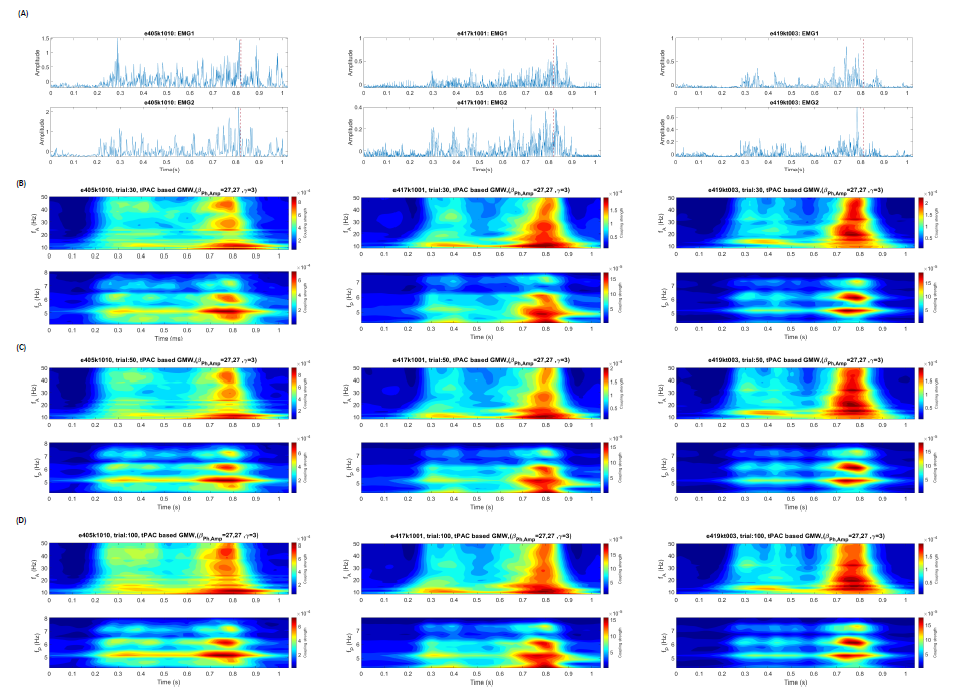Performance evaluation of wavelet time-resolved phase-amplitude coupling estimates on small numbers of trials
Main Article Content
Abstract
Time-resolved phase-amplitude coupling (tPAC) is increasingly used in clarifying the interactions between neuronal oscillation
of different frequencies. In this study, Airy wavelet-based method for tPAC estimates on small numbers of trials is presented.
The method was validated using both synthesized and experimental data. Simulation results suggested that tPAC analysis using
more than 15 trials oers better joint time-frequency resolution. Experimental results showed that tPAC estimates on 30-,
50-, and 100-step cycles are able to detect similar significant coupling in the time-frequency plane. Dominant couplings are
between 6 Hz and 8-32 Hz around heel contact. These frequency components partly overlap with the frequency components
of motor unit activity during human treadmill walking. Wavelet tPAC analysis presented in this study may be used to track timelocalised
common oscillations in short segments of non-stationary neurophysiological signals with varying time and frequency
resolution.
Article Details
References
J.-S. Brittain, C. Catton, B. Conway, J. Nielsen, N. Jenkin-son, D. Halliday, Optimal spectral tracking-with application tospeed dependent neural modulation of tibialis anterior duringhuman treadmill walking, Journal of Neuroscience Methods177 (2009) 334–347.
D. Halliday, S. Farmer, On the need for rectification of surfaceEMG, Journal of Neurophysiology 103 (2010) 3547.
D. Allen,C. Mackinnon,Time-frequency analysis ofmovement-related spectral power in eeg during repetitivemovements: A comparison of methods, Journal of Neuro-science Methods 186 (2010) 107–115.
F. Artoni, C. Fanciullacci, F. Bertolucci, A. Panarese, S.Makeig, S. Micera, C. Chisari, Unidirectional brain to muscleconnectivity reveals motor cortex control of leg muscles duringstereotyped walking, NeuroImage 159 (2017) 403–416.
P. Grosse, M. Cassidy, P. Brown, EEG-EMG, MEG-EMG andEMG-EMG frequency analysis: physiological principles andclinical applications, Clinical Neurophysiology 113 (10) (2002)1523–1531.
J. Lilly, S. Olhede, On the analytic wavelet transform, IEEETransactions on Information Theory 56 (2010) 4135–4156.
J.-S. Brittain, D. Halliday, B. Conway, J. Nielsen, Singletrialmultiwavelet coherence in application to neurophysiologicaltime series, IEEE Transactionson Biomedical Engineering 54(5) (2007) 854–862.
J. Lilly, S. Olhede, Generalized morse wavelet as a superfamilyof analytic wavelets, IEEE Transactions on Signal Processing60 (11) (2012) 6036–6041.
P. Wang, J. Gao, Extraction of instantaneous frequency fromseismic data via the generalized morse wavelets, Journal of Ap-plied Geophysics 93 (Supplement C) (2013) 83–92.
L. Aguiar-Conraria, M. Soares, The continuous wavelet trans-form: moving beyond uni- and bivariate analysis, Journal ofEconomic Surveys 28 (2) (2014) 344–375.
A. Nakhnikian, S. Ito, L. Dwiel, L. Grasse, G. Rebec, L. Lau-ridsen, J. Beggs, A novel cross-frequency coupling detectionmethod using the generalized morse wavelets, Journal of Neu-roscience Methods 269 (2016) 61–73.
A. Tort, M. Kramer, C. Thorn, D. Gibson, Y. Kubota, A.Graybiel, N. Kopell, Dynamic cross-frequency couplings of lo-cal field potential oscillations in rat striatum and hippocampusduring performance of a t-maze task, PNAS 105 (51) (2008)20517–20522.
A. Onslow, R. Bogacz, M. Jones, Quantifying phaseampli-tude coupling in neuronal network oscillations, Progress in Bio-physics and Molecular Biology 105 (1–2) (2011) 49–57.
R. Canolty, C. Cadieu, K. Koepsell, K. R.T., J. Carmena, Mul-tivariate phase-amplitude cross-frequency coupling in neuro-physiological signals, IEEE Transactions on Biomedical Engi-neering 59 (1) (2012) 8–11.
B. Voytek, M. D’Esposito, N. Crone, R. Knight, A method forevent-related phase/amplitude coupling, NeuroImage 64 (2013)416–424.
A. Vaz, R. Yaffe, J. Wittig Jr, S. Inati, K. Zaghloul, Dual ori-gins of measured phase-amplitude coupling reveal distinct neu-ral mechanisms underlying episodic memory in the human co-tex, NeuroImage 148 (2017) 148–159.
W. Penny, E. Duzel, K. Miller, J. Ojemann, Testing for nestedoscillation, Journal of Neuroscience Methods 174 (1) (2008)50–61.
A. Tort, R. Komorowski, H. Eichenbaum, N. Kopell, Mea-suring phase-amplitude coupling between neuronal oscillationof different frequencies, Journal of Neurophysiology 104 (4)(2010) 1195–1210.
R. Canolty, R. Knight, The functional role of cross-frequencycoupling, Trends in Cognitive Sciences 14 (11) (2010) 506–515.
B. Pittman-Polletta, W.-H. Hsieh, S. Kaur, M.-T. Lo, K. Hu,Detecting phase-amplitude coupling with high frequency reso-lution using adaptive decompositions, Journal of NeuroscienceMethods 226 (2014) 15–32.
A. Dvorak, A. Fenton, Toward a proper estimation of phase-amplitude coupling in neural oscillations, Journal of Neuro-science Methods 225 (2014) 42–56.
S. Samiee, S. Baillet, Time-resolved phase-amplitude cou-pling in neural oscillations, NeuroImage 159 (2017) 270–279.
J. Lilly, S. Olhede, High-order properties of analytic wavelets,IEEE Transactions on Signal Processing 57 (1) (2009) 146–160.
S. Olhede, A. Walden, Generalized morse wavelets, IEEETransactions on Signal Processing 50 (11) (2002) 2661–2669.
T. ̈Ozkurt, A. Schnitzler, A critical note on the definition ofphase-amplitude cross-frequency coupling, Journal of Neuro-science Methods 201 (2) (2011) 438–443.
J. Aru, J. Aru, V. Priesemann, M. Wibral, L. Lana, G. Pipa,W. Singer, R. Vicente, Untangling cross-frequency coupling inneuroscience, Current Opinion in Neurobiology 31 (2015) 51–61.
D. Thengone, K. Gagnidze, D. Pfaff, A. Proekt, Phaseampli-tude coupling in spontaneous mouse behavior, PLOS ONE 11(9) (2016) 1–19.
D. Halliday, B. Conway, Christensen, N. Hansen, N. Petersen,Nielsen, Functional coupling of motor units is modulated dur-ing walking in human subjects, Journal of Neurophysiology 89(2003) 960–968.
S. Suwansawang, D. Halliday, Time-frequency based coher-ence and phase locking value analysis of human locomotiondata using generalized morse wavelets, in: Proceedings of the10th International Joint Conference on Biomedical Engineer-ing Systems and Technologies (BIOSTEC 2017) - Volume 4:BIOSIGNALS, Porto, Portugal, 2017, pp. 34–41.
T. H. Petersen, M. Willerslev-Olsen, B. Conway, J. Nielsen,The motor cortex drives the muscles during walking in humansubjects, The Journal of Physiology 590 (Pt 10) (2012) 2443–2452.


